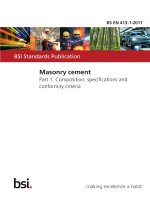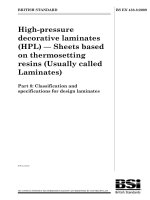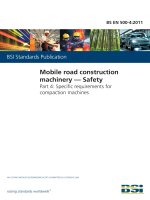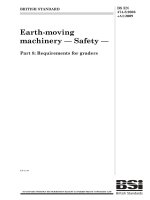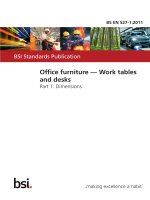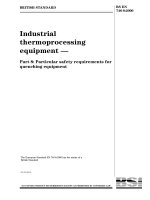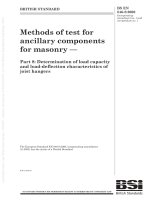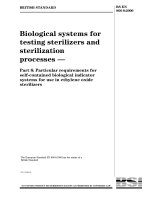Bsi bs en 62047 8 2011
Bạn đang xem bản rút gọn của tài liệu. Xem và tải ngay bản đầy đủ của tài liệu tại đây (1.63 MB, 22 trang )
BS EN 62047-8:2011
BSI Standards Publication
Semiconductor devices —
Micro-electromechanical
devices
Part 8: Strip bending test method for tensile
property measurement of thin films
NO COPYING WITHOUT BSI PERMISSION EXCEPT AS PERMITTED BY COPYRIGHT LAW
raising standards worldwide™
BRITISH STANDARD
BS EN 62047-8:2011
National foreword
This British Standard is the UK implementation of EN 62047-8:2011. It is
identical to IEC 62047-8:2011.
The UK participation in its preparation was entrusted to Technical Committee
EPL/47, Semiconductors.
A list of organizations represented on this committee can be obtained on
request to its secretary.
This publication does not purport to include all the necessary provisions of a
contract. Users are responsible for its correct application.
© BSI 2011
ISBN 978 0 580 60629 8
ICS 31.080.99
Compliance with a British Standard cannot confer immunity from
legal obligations.
This British Standard was published under the authority of the Standards
Policy and Strategy Committee on 30 June 2011.
Amendments issued since publication
Amd. No.
Date
Text affected
BS EN 62047-8:2011
EUROPEAN STANDARD
EN 62047-8
NORME EUROPÉENNE
May 2011
EUROPÄISCHE NORM
ICS 31.080.99
English version
Semiconductor devices Micro-electromechanical devices Part 8: Strip bending test method for tensile property measurement of thin
films
(IEC 62047-8:2011)
Dispositifs à semiconducteurs Dispositifs microélectromécaniques Partie 8: Méthode d'essai de la flexion de
bandes en vue de la mesure des
propriétés de traction des couches minces
(CEI 62047-8:2011)
Halbleiterbauelemente Bauelemente der Mikrosystemtechnik Teil 8: Streifen-Biege-Prüfverfahren zur
Messung von
Zugbeanspruchungsmerkmalen dünner
Schichten
(IEC 62047-8:2011)
This European Standard was approved by CENELEC on 2011-04-18. CENELEC members are bound to comply
with the CEN/CENELEC Internal Regulations which stipulate the conditions for giving this European Standard
the status of a national standard without any alteration.
Up-to-date lists and bibliographical references concerning such national standards may be obtained on
application to the Central Secretariat or to any CENELEC member.
This European Standard exists in three official versions (English, French, German). A version in any other
language made by translation under the responsibility of a CENELEC member into its own language and notified
to the Central Secretariat has the same status as the official versions.
CENELEC members are the national electrotechnical committees of Austria, Belgium, Bulgaria, Croatia, Cyprus,
the Czech Republic, Denmark, Estonia, Finland, France, Germany, Greece, Hungary, Iceland, Ireland, Italy,
Latvia, Lithuania, Luxembourg, Malta, the Netherlands, Norway, Poland, Portugal, Romania, Slovakia, Slovenia,
Spain, Sweden, Switzerland and the United Kingdom.
CENELEC
European Committee for Electrotechnical Standardization
Comité Européen de Normalisation Electrotechnique
Europäisches Komitee für Elektrotechnische Normung
Management Centre: Avenue Marnix 17, B - 1000 Brussels
© 2011 CENELEC -
All rights of exploitation in any form and by any means reserved worldwide for CENELEC members.
Ref. No. EN 62047-8:2011 E
BS EN 62047-8:2011
EN 62047-8:2011
-2-
Foreword
The text of document 47F/71/FDIS, future edition 1 of IEC 62047-8, prepared by SC 47F,
Micro-electromechanical systems, of IEC TC 47, Semiconductor devices, was submitted to the IECCENELEC parallel vote and was approved by CENELEC as EN 62047-8 on 2011-04-18.
Attention is drawn to the possibility that some of the elements of this document may be the subject of
patent rights. CEN and CENELEC shall not be held responsible for identifying any or all such patent
rights.
The following dates were fixed:
– latest date by which the EN has to be implemented
at national level by publication of an identical
national standard or by endorsement
(dop)
2012-01-18
– latest date by which the national standards conflicting
with the EN have to be withdrawn
(dow)
2014-04-18
__________
Endorsement notice
The text of the International Standard IEC 62047-8:2011 was approved by CENELEC as a European
Standard without any modification.
In the official version, for Bibliography, the following notes have to be added for the standards indicated:
IEC 62047-2:2006
NOTE Harmonized as EN 62047-2:2006 (not modified).
IEC 62047-3:2006
NOTE Harmonized as EN 62047-3:2006 (not modified).
__________
BS EN 62047-8:2011
–2–
62047-8 IEC:2011
CONTENTS
1
Scope . ............................................................................................................................................. 5
2
Normative references . .................................................................................................................. 5
3
Terms and definitions . .................................................................................................................. 5
4
Test apparatus . ............................................................................................................................. 5
5
4.1
4.2
4.3
4.4
4.5
4.6
Test
General ................................................................................................................................. 5
Actuator ................................................................................................................................ 6
Load tip ................................................................................................................................. 6
Alignment mechanism . ....................................................................................................... 6
Force and displacement sensors . ..................................................................................... 6
Test environment. ................................................................................................................ 6
piece . ..................................................................................................................................... 6
6
5.1
5.2
5.3
Test
General ................................................................................................................................. 6
Shape of test piece ............................................................................................................. 7
Measurement of test piece dimension . ............................................................................. 7
procedure and analysis . ....................................................................................................... 8
6.1
6.2
7
General ................................................................................................................................. 8
Data analysis ....................................................................................................................... 8
Test report. ..................................................................................................................................... 9
Annex A (informative) Data analysis: Test results by using nanoindentation apparatus . ....... 10
Annex B (informative) Test piece fabrication: MEMS process . ................................................... 13
Annex C (informative) Effect of misalignment and geometry on property measurement . ....... 15
Bibliography ......................................................................................................................................... 18
Figure 1 – Thin film test piece ............................................................................................................. 7
Figure 2 – Schematic of strip bending test . ...................................................................................... 9
Figure A.1 – Three successive indents for determining the reference location of a test
piece . ................................................................................................................................................... 10
Figure A.2 – A schematic view of nanoindentation apparatus . .................................................... 11
Figure A.3 – Actuator force vs. deflection curves for strip bending test and for leaf
spring test . ........................................................................................................................................... 11
Figure A.4 – Force vs. deflection curve of a test piece after compensating the stiffness
of the leaf spring ................................................................................................................................. 12
Figure B.1 – Fabrication procedure for test piece .......................................................................... 13
Figure C.1 – Finite element analysis of errors based on the constitutive data of Au thin
film of 1 µm thick ................................................................................................................................ 16
Figure C.2 – Translational (d) and angular ( α , β , γ ) misalignments . ........................................... 17
Table 1 – Symbols and designations of a test piece . ...................................................................... 7
BS EN 62047-8:2011
62047-8 IEC:2011
–5–
SEMICONDUCTOR DEVICES –
MICRO-ELECTROMECHANICAL DEVICES –
Part 8: Strip bending test method
for tensile property measurement of thin films
1
Scope
This international standard specifies the strip bending test method to measure tensile
properties of thin films with high accuracy, repeatability, moderate effort of alignment and
handling compared to the conventional tensile test. This testing method is valid for test pieces
with a thickness between 50 nm and several µm, and with an aspect ratio (ratio of length to
thickness) of more than 300.
The hanging strip (or bridge) between two fixed supports are widely adopted in MEMS or
micro-machines. It is much easier to fabricate these strips than the conventional tensile test
pieces. The test procedures are so simple to be readily automated. This international
standard can be utilized as a quality control test for MEMS production since its testing
throughput is very high compared to the conventional tensile test.
2
Normative references
The following referenced documents are indispensable for the application of this document.
For dated references, only the edition cited applies. For undated references, the latest edition
of the referenced document (including any amendments) applies.
NONE
3
Terms and definitions
For the purposes of this document the following terms and definitions apply.
3.1
deflection
w
displacement of a test piece at the middle of the length, which is measured with respect to the
straight line connecting two fixed ends of the test piece
3.2
deflection angle
β
angle between the deformed test piece and the straight line connecting two fixed ends of the
test piece
NOTE
4
4.1
Test piece in this document is often referred to as a strip bending specimen.
Test apparatus
General
A test apparatus is composed of an actuator, a load-sensor, a displacement sensor, and
alignment mechanism as other mechanical testers such as micro-tensile tester and
BS EN 62047-8:2011
–6–
62047-8 IEC:2011
nanoindentation apparatus. A test piece in a form of strip is very compliant and experiences
large deflection under a small load when comparing it with a micro-tensile test piece with
similar dimensions. In this respect, the load-sensor should have an excellent resolution and
the displacement sensor should have a long measuring range. Details on each component of
test apparatus are described as follows.
4.2
Actuator
All actuating devices that are capable of linear movement can be used for the test, e.g.
piezoelectric actuator, voice coil actuator, servo motor, etc. However, a device with fine
displacement resolution is highly recommended due to small dimensions of the test piece.
The resolution shall be better than 1/1 000 of maximum deflection of test piece.
4.3
Load tip
The load tip which applies a line contact force to the test piece is shaped like a conventional
wedge type indenter tip and can be made of diamond, sapphire or other hard materials. The
radius of the tip shall be comparable to or larger than the thickness of the test piece, and less
than L/50 (refer to Annex C.3).
4.4
Alignment mechanism
The load tip shall be installed on the test apparatus aligned with the load and the
displacement measuring axes, and the misalignment shall be less than 1 degree. The load tip
shall be also aligned to the surface of the test piece with the deviation angles less than 1
degree (refer to Annex C for definition of deviation angles and error estimation of
misalignment). It is desirable to equip the apparatus with tilt stages for adjusting the deviation
angle. The load tip is to be positioned at the centre of the test piece and the positional
accuracy shall be less than L/100.
4.5
Force and displacement sensors
Force and displacement sensors shall have resolutions better than 1/1 000 of the maximum
force and deflection during the test. The accuracy of the sensors shall be within ± 1 % of the
range. The displacement sensors can be capacitive type, LVDT type, or optical type with
acceptable resolution and accuracy. In practice, the deflection can be measured from the
motion of the load tip using a capacitive sensor or from the deflection of the test piece using
an optical method.
4.6
Test environment
It is recommended to perform a test under constant temperature and humidity. Temperature
change can induce thermal drift during deflection measurement. The temperature change or
thermal drift shall be checked before and after the test.
5
5.1
Test piece
General
The test piece shall be prepared by using the same fabrication process as the actual device
fabrication. To minimize the size effect of a test piece, the structure and size of the test piece
shall be similar to those of the device components.
There are many fabrication methods of the test piece depending on the applications. As an
example, the fabrication of the test piece based on MEMS process is described in Annex B. A
lot of strip bending test pieces can be fabricated on a die or a substrate.
BS EN 62047-8:2011
62047-8 IEC:2011
5.2
–7–
Shape of test piece
The shape of test piece and symbols are given in Figure 1 and Table 1, respectively. The test
piece shall be designed to minimize the bending moment effect. In order to minimize the
effect, the maximum deflection shall be more than 40 times the thickness of the test piece,
and the length of the test piece shall be more than 300 times the thickness of the test piece,
and the width shall be more than 10 times the thickness of the test piece, and the length shall
be 10 times larger than the width. The thickness of the substrate shall be more than 500 times
that of the test piece. The dimension of the substrate is limited by the capacity of the test
apparatus. The geometry of the fixed ends supporting the test piece can affect the test results.
When etching the sacrificial layer and the supporting substrate of test pieces, the region
beneath the test pieces can be over-etched, and this is called by under-cut. The under-cut at
the fixed ends shall be minimized (anisotropic etching would be desirable rather than isotropic
etching).
IEC
499/11
Figure 1 – Thin film test piece
Table 1 – Symbols and designations of a test piece
5.3
Symbol
Unit
Designation
l1
µm
Length of a test piece (=2L)
l2
µm
Width of a test piece (=B)
l3
µm
Thickness of a test piece (=h)
Measurement of test piece dimension
To analyze the test results, the accurate measurement of the test piece dimensions is
required since the dimensions are used to extract mechanical properties of test materials. The
length (2L), width (B), and thickness (h) shall be measured with very high accuracy with less
than ± 5 % error. Useful information on thickness measurement can be found in Annex C of
[1] 1 and in Clause 6 of [2].
—————————
1 Figures in square brackets refer to the Bibliography.
BS EN 62047-8:2011
–8–
6
62047-8 IEC:2011
Test procedure and analysis
6.1
General
a) The substrate containing test pieces is attached to a sample holder. There are some
recommendable methods for the sample attachment, such as magnetic attachment,
electrostatic gripping, adhesive gluing, etc.
b) The translational and angular misalignment between the load tip and the test piece can
affect the test results (refer to Figure C.2), and should be checked using an optical
microscope. The misalignment error and the guideline for alignment are described in
Annex C.
c) It is necessary to determine surface location of a test piece at the beginning of the test.
The surface location is the position of the top surface of the test piece in the vertical
direction when the strip deforms by the vertical movement of the load tip. This surface
location can be determined by optical inspection using an optical microscope, or be
determined by three successive indents. When the load tip touches the strip, the slight
change in the strip configuration can be observed and identified using the optical
microscope. The detailed method for determining the surface location using three
successive indents is described in A.3.
d) The test is performed under a constant displacement rate until the strip ruptures. The
displacement rate of L × 10 −4 / s or L × 10 −3 / s is recommended, which leads to the strain rate
of approximately 1 × 10 −5 / s or 1 × 10 −4 / s , respectively when the strain reaches 0,5 %. This
method applies to strain rate insensitive materials since the strain rate changes during the
test.
6.2
Data analysis
To obtain an actual force and deflection data of a test piece from the experimental results,
several compensations may be required depending on the test apparatus. As an example, the
data analysis procedures are described in Annex A for the case of a nanoindentation
apparatus. These procedures can provide useful information for other types of apparatus.
From the force and deflection measurements, stress and strain can be estimated by the
following Equations (1) and (2). The equations are derived on the assumptions of negligible
bending moment effect and uniform strain throughout the test piece [1-3]. See Figure 2.
σ=
ε=
Here,
σ
is the strip stress,
ε
F
,
2Bh sin β
(1)
L2 + w2
−1.
L
(2)
is the strip strain, F is the force applied to a test piece during
test and w is its corresponding deflection, β is defined as tan −1 ( w / L) . When L/h is larger than
300, these equations yield an excellent estimation of elastic modulus and yield strength as
verified in Annex C. The effect of internal stress or residual stress could be considered with
this method. When the internal stress exists, "F" in the equation (1) is affected by the internal
stress and the strip stress changes also. The buckled test piece is excluded in this standard.
BS EN 62047-8:2011
62047-8 IEC:2011
–9–
(F)
β
w
L
IEC
500/11
Figure 2 – Schematic of strip bending test
7
Test report
The test report shall contain at least the following information;
a) reference to this international standard;
b) identification number of the test piece;
c) fabrication procedures of the test piece;
d) test piece material;
–
in case of single crystal: crystallographic orientation
–
in case of poly crystal: texture and grain sizes
e) test piece dimension and measurement method;
f)
description of testing apparatus;
g) measured properties and results: elastic modulus, tensile strength, yield strength and
stress-strain curve.
BS EN 62047-8:2011
– 10 –
62047-8 IEC:2011
Annex A
(informative)
Data analysis: Test results by using nanoindentation apparatus
A.1
Cause of errors
Thermal drift, difficulty of finding the surface location of the test piece and leaf spring stiffness
of test apparatus can affect the test results.
A.2
Thermal drift compensation
Thermal drift is a common cause of error for a precise sensor measurement. This error is
regarded as the result of thermal fluctuation from the test system. To measure thermal drift,
the deflection is recorded for a period of time under a load controlled condition while a test
piece is in contact with the wedge tip. Using the drift data, the deflection data of the strip
bending test are corrected. This is a common compensation method of a nanoindentation test.
Since the creep deformation is not clearly distinguished from the thermal drift, this
compensation is not used in case of a test piece with creep behaviour.
A.3
Determination of surface location
Finding the surface location of a test piece is very difficult since the stiffness change is too
small to detect when the wedge tip is in contact with the test piece. As an alternative method,
the surface locations of the two fixed strip ends to substrate are measured and the average
value of the surface locations is taken as the surface location of the strip. See Figure A.1.
This method can determine a reference surface location even for a wrinkled film caused by
compressive residual stress. The deflection of a test piece is measured from that reference
surface location.
IEC
Figure A.1 – Three successive indents for determining
the reference location of a test piece
501/11
BS EN 62047-8:2011
62047-8 IEC:2011
– 11 –
IEC
502/11
Figure A.2 – A schematic view of nanoindentation apparatus
(µm)
IEC
NOTE
503/11
The test piece is Au film with a thickness of 0,1 µm, a width of 10 µm, and a length of 400 µm.
Figure A.3 – Actuator force vs. deflection curves
for strip bending test and for leaf spring test
A.4
Leaf spring stiffness compensation
Many commercial nanoindenation systems are utilizing a leaf spring to achieve a highly
repeatable linear motion. See Figure A.2. This apparatus applies a force on a test piece by
controlling the electric current supplied to the electromagnetic actuator. The actuator force is
obtained from the electric current multiplied by load calibration constant. The actual force on a
test piece can be determined by subtraction of the force for the leaf spring deformation from
the actuator force. The leaf spring force can be measured by moving actuator without any test
piece. This is represented by the open circle curve in Figure A.3. In order to compensate for
the leaf spring force, the force-deflection data without a test piece are subtracted from the
force-deflection data with a test piece (the filled square curve in Figure A.3). The actual force
BS EN 62047-8:2011
62047-8 IEC:2011
– 12 –
(µN)
signal on a strip can be determined by this procedure. See Figure A.4. The detailed
information on the data analysis can be found in [3], [4] and [5].
(µm)
IEC
504/11
Figure A.4 – Force vs. deflection curve of a test piece
after compensating the stiffness of the leaf spring
BS EN 62047-8:2011
62047-8 IEC:2011
– 13 –
Annex B
(informative)
Test piece fabrication: MEMS process
B.1
Test piece fabrication
MEMS processes are possible candidates for fabricating the test piece. Several types of
MEMS process can be developed depending on the test materials and the devices. Figure B.1
introduces one example among the various MEMS processes. Detail descriptions are given
below.
a) deposit oxide film on a Si wafer.
b) deposit a thin film of the test material on the oxide film. Au, Mo, SiNx can be used as a
test material. A glue layer may be deposited to improve adhesion between oxide film and
thin film. The thickness of the glue layer must be carefully chosen to minimize its stiffness
effect on the measurement.
c) pattern the metal film to define the shape of a test piece. The patterning is done by a
photolithography process.
d) protect the patterned test piece by oxide or photoresist passivation layer.
e) to make freestanding films, Si substrate is etched from back side by using deep RIE.
f)
freestanding film is obtained by removing photoresist and oxide.
IEC
Figure B.1 – Fabrication procedure for test piece
505/11
BS EN 62047-8:2011
– 14 –
B.2
62047-8 IEC:2011
Measurement of shape of test piece
The shape of test piece can be measured by various methods. Stylus profilers or AFM (atomic
force microscope) can be used to measure the thickness of a test piece. The width and length
of a test piece are measured by electron microscope or even optical microscope. In case of a
wrinkled film caused by compressive residual stress, the length between the fixed ends of
strip to substrate is taken as the length of a test piece.
BS EN 62047-8:2011
62047-8 IEC:2011
– 15 –
Annex C
(informative)
Effect of misalignment and geometry on property measurement
C.1
Background
The results obtained by the strip bending test can be affected by several error sources. Some
of them are the geometry of a test piece and others are translational and angular
misalignments. Using finite element simulation, the effects of these error sources are
estimated, and useful guidelines for the test are suggested. The test piece has three length
parameters, length, width and thickness. The effects of these parameters are estimated under
perfect alignment in terms of the error in elastic modulus and yield strength. The errors due to
the translational and angular misalignments are estimated. The details on the simulation can
be found in [6].
C.2
Finite element analysis
Three-dimensional finite element models are generated for the strip bending test pieces and
are simulated using commercial finite element software, such as e.g. ABAQUS. By performing
a mesh convergence study, the suitable finite element model is selected, which gives a
convergent numerical solution. The material properties are adopted from the tensile test
results [7] of Au thin film with a thickness of 1 µm, and the constitutive models for the
simulation are elasticity and incremental plasticity. Using the finite element simulation, the
force and deflection data for a test piece are extracted, and the corresponding stress and
stress data are evaluated using the equations in 4.2. Elastic modulus and yield strength (0,2%
offset) can be calculated from the evaluated stress-strain data. The error is estimated from
the difference between the calculated ones and the simulation inputs.
C.3
Analysis results
The errors in elastic modulus and yield strength under perfect alignment are estimated from
the finite element analysis and are plotted in Figure C.1. As the increase in length/thickness
ratio, the errors in elastic modulus and yield strength decreases, and the estimated properties
are a little less than the actual properties. When the length/thickness ratio is larger than 300,
the errors become less than 1 %.
BS EN 62047-8:2011
62047-8 IEC:2011
– 16 –
10
8
B/h = 10
B/h = 20
B/h = 30
Elastic modulus error, %
6
4
2
0
-2
-4
-6
-8
-10
0
100
200
300
400
500
Aspect ratio (L/h)
IEC
Figure C.1a)
506/11
Finite element analysis of errors in elastic modulus with respect
to aspect ratio (= length/thickness)
10
8
B/h = 10
B/h = 20
B/h = 30
Yield stress error, %
6
4
2
0
-2
-4
-6
-8
-10
0
100
200
300
400
500
Aspect ratio (L/h)
IEC
Figure C.1b)
507/11
Finite element analysis of errors in yield strength evaluation with respect
to aspect ratio (= length/thickness)
Figure C.1 – Finite element analysis of errors based on the constitutive data
of Au thin film of 1 µm thick
BS EN 62047-8:2011
62047-8 IEC:2011
– 17 –
The translational and angular misalignments are also analyzed for the configuration shown in
Figure C.2. Based on the simulation results, it is found that the effect of the translational
misalignment (d) on elastic modulus and strength is less than 0,1% when d is less than L/100.
Among the angular misalignments, α has the most significant effect on the results, and the
error caused by α increases as the width, B. When B/h is 10 and α is less than 1 degree, the
errors in elastic modulus and yield strength is less than 0,5 %. The effects of β and γ on the
elastic modulus and yield strength is less than 0,1 % when they are less than 1 degree.
The effect of the load-tip radius on elastic modulus and strength evaluation is also estimated.
As the radius increases, the errors in elastic modulus and strength also increase. The error in
strength grows faster than that in elastic modulus. When the radius is less than L/50, the
errors are less than 0,5 %.
IEC
508/11
Figure C.2 – Translational (d) and angular ( α , β , γ ) misalignments
BS EN 62047-8:2011
– 18 –
62047-8 IEC:2011
Bibliography
[1]
IEC 62047-2:2006, Semiconductor devices – Micro-electromechanical devices – Part 2:
Tensile testing method of thin film materials.
[2]
IEC 62047-3:2006, Semiconductor devices – Micro-electromechanical devices – Part 3:
Thin film standard test piece for tensile testing.
[3]
Espinosa, H. D., Prorok, B. C., Fisher, M., A methodology for determining mechanical
properties of freestanding thin films and MEMS materials, Journal of the Mechanics and
Physics of Solids, Vol. 51 (2003), pp. 47-67.
[4]
Baek, C. W., Kim, J. M., Kim, Y. K., Kim, J.-H., Lee, H.-J., Han, S.-W., Mechanical
Characterization of Gold Thin Films Based on Strip Bending and Nanoindentation Test
for MEMS/NEMS Applications, Sensors and Materials, Vol. 17 (2005), pp. 277-288.
[5]
Kim, J.-H., Lee, H.-J., Han, S.-W., Kim, J. M., Baek, C. W., Residual Stress Evaluation
of Thin Film Using Strip Bending Test, Key Engineering Materials, Vols. 321-323 (2006),
pp. 121-124.
[6]
Park, J.-M., Kim, J.-H., Lee, H.-J., A study on error sources of strip bending test using
finite element analysis, Proc. of KSPE 2007 fall meeting (2007).
[7]
Lee, S.-J., Hyun, S.-M., Han, S.-W., Lee, H.-J., Kim, J. H., Kim, Y. I., A Study of
Mechanical Behavior of Au Films by Visual Image Tracing System, Advanced Materials
Research, Vols. 26-28 (2007), pp. 1117-1120.
____________
This page deliberately left blank
This page deliberately left blank
British Standards Institution (BSI)
BSI is the independent national body responsible for preparing British Standards
and other standards-related publications, information and services.
It presents the UK view on standards in Europe and at the international level.
It is incorporated by Royal Charter.
Revisions
Information on standards
British Standards are updated by amendment or revision. Users of British Standards should make sure that they possess the latest amendments or editions.
It is the constant aim of BSI to improve the quality of our products and services. We would be grateful if anyone finding an inaccuracy or ambiguity while
using this British Standard would inform the Secretary of the technical committee responsible, the identity of which can be found on the inside front
cover.
Tel: +44 (0)20 8996 9001 Fax: +44 (0)20 8996 7001
BSI provides a wide range of information on national, European
and international standards through its Knowledge Centre.
BSI offers Members an individual updating service called PLUS which ensures
that subscribers automatically receive the latest editions of standards.
Tel: +44 (0)20 8996 7669 Fax: +44 (0)20 8996 7001
Email:
Buying standards
You may buy PDF and hard copy versions of standards directly using a
credit card from the BSI Shop on the website www.bsigroup.com/shop.
In addition all orders for BSI, international and foreign standards publications
can be addressed to BSI Customer Services.
Tel: +44 (0)20 8996 9001 Fax: +44 (0)20 8996 7001
Email:
In response to orders for international standards, it is BSI policy to
supply the BSI implementation of those that have been published
as British Standards, unless otherwise requested.
Tel: +44 (0)20 8996 7004 Fax: +44 (0)20 8996 7005
Email:
Various BSI electronic information services are also available which
give details on all its products and services.
Tel: +44 (0)20 8996 7111 Fax: +44 (0)20 8996 7048
Email:
BSI Subscribing Members are kept up to date with standards
developments and receive substantial discounts on the purchase price
of standards. For details of these and other benefits contact Membership Administration.
Tel: +44 (0)20 8996 7002 Fax: +44 (0)20 8996 7001
Email:
Information regarding online access to British Standards via British
Standards Online can be found at www.bsigroup.com/BSOL
Further information about BSI is available on the BSI website at www.bsigroup.com/standards
Copyright
Copyright subsists in all BSI publications. BSI also holds the copyright,
in the UK, of the publications of the international standardization bodies. Except as permitted under the Copyright, Designs and Patents Act 1988 no extract may be reproduced, stored in a retrieval system or transmitted in any
form or by any means – electronic, photocopying, recording or otherwise –
without prior written permission from BSI. This does not preclude the free
use, in the course of implementing the standard of necessary details such as
symbols, and size, type or grade designations. If these details are to be used
for any other purpose than implementation then the prior written permission
of BSI must be obtained. Details and advice can be obtained from the Copyright & Licensing Manager.
Tel: +44 (0)20 8996 7070
Email:
BSI Group Headquarters
389 Chiswick High Road London W4 4AL UK
Tel +44 (0)20 8996 9001
Fax +44 (0)20 8996 7001
www.bsigroup.com/standards
raising standards worldwide™
